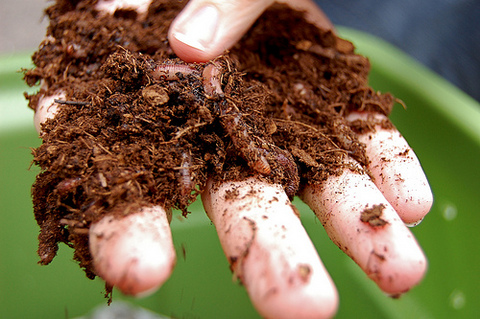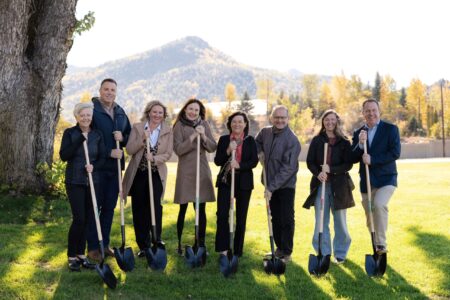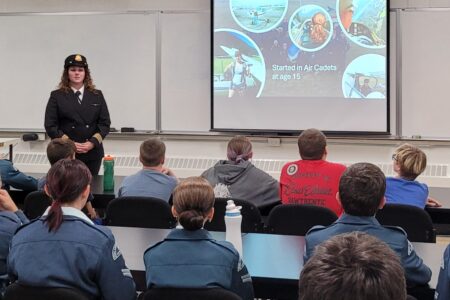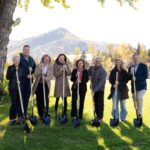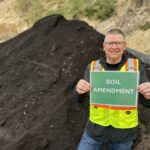K is for Kompost as Kootenay Boundary faces landfill Krunch
After great success in the Grand Forks pilot project that’s gone city-wide, but also spurred by a looming local landfill crisis and millions of dollars in imminent savings from recycling programs, the stars may finally have aligned for a regional composting service—a.k.a. “organics diversion”—said Alan Stanley, the Director of Environmental Services for the Regional District of Kootenay Boundary (RDKB).
A number of important trends have converged, from positive political will on the RDKB board to new calculations on the expected life of the McKelvey Creek Landfill in Trail that suggest its financially critical to divert the organics.
In addition, more than $1.2 million in the annual RDKB recycling budget will be freed up in May, 2014, thanks to new provincial product stewardship laws that will put the recycling onus on industry instead of government. We give those details in a separate article.
Stanley said that the landfill crisis can be averted by redirecting the RDKB’s recycling budget to a regional green bin program and composting facility modelled after the successful pilot in Grand Forks. “We’ve got a huge opportunity here over the next couple years to move into a regional organics diversion program,” he said.
The ticking time bomb at McKelvey Creek
The Trail landfill, which services about 20,000 people, is an “almost irreplaceable public asset,” Stanley said, “People don’t think about the landfill like they do about the arena, or the library, or a new main street. But when you start trying to figure out, if this one fills up, what do we do next?”
“You realize very quickly how valuable it is,” he continued. “Try to site a new landfill these days: it’s virtually impossible. You might get into an export program and have to build transfer systems for tens of millions of dollars—on top of truck drivers and fuel and all the rest of that. If you can actually find a place to build a new landfill, then the construction and environmental controls to build one these days add to an almost unimaginable cost.”
Closing a full landfill isn’t straightforward either. “We probably have to monitor it for 25 years of more [for environmental effects], and there’s a lot of construction to cap it as well,” Stanley said.
Anticipating these future costs, the RDKB puts aside money each year in a “closure reserve.” Unfortunately, the last time RDKB hired engineers to calculate the expected lifespan and construction costs was in 2002. Since then, not only have construction costs increased, but the 2002 calculations had depended on a plan to partner with the RDCK (Central Kootenay) to divert organics to a central plant.
Although the plan was seriously considered, it never happened and organics continue to pile into McKelvey Creek Landfill, dramatically shortening its expected lifespan. How much shorter is a difficult question, but a recent engineering report suggests 26 years, with estimated closure costs tripling from the $3 million estimated in 2002 to $9 million.
“Based on the aggressive diversion program they’d anticipated [in 2002], we were putting away $7400 per year for the McKelvey Creek closure reserve,” Stanley explained. “We recalculated based on the fact that we weren’t doing organics diversion and the increased cost of construction: we lost 26 years of lifespan in the landfill, and the annual closure reserve expense went from $7400 to $142,000.”
Defusing the bomb
“If we could do an organics diversion program and get those 26 years back, we could probably save $100,000 per year in transfers to the closure reserve,” Stanley estimated.
But that’s not the big money, Stanley continued. The big money will come in May 2014 when industries across the province take full responsibility for the paper and packaging they produce.
The timing is just right to get into regional composting as regional recycling contracts expire right when industry is supposed to take over the blue bin programs.
“Here’s an opportunity,” Stanely said. “Without raising taxes or fees, we can reprofile this money into an organics diversion program. If we play our cards right at that point, maybe we could do garbage and organics collection right off the bat.”
The political will is there
“The [RDKB] board is fully committed to moving this thing forward,” Stanley said. “I’m thrilled that elected officials have taken the time to understand it as well as they have. We’ve got a bunch of people who really pay attention—Credit where credit’s due.”
“They’ve been incredibly progressive in terms of understanding things like EPR and product stewardship programs. And they listen to the information as to how that would fit into what we’re mandated to do by the province. The board’s been incredibly patient and paid a lot of attention to all of this,” he said.
Coun. Kathy Wallace, for example, is Rossland’s director on the board and frequently brings Rossland council encouraging news about the progress in regional waste management, and speaks highly of the benefits (and urgent necessity) of regional composting.
The RDKB’s strategic plan, put together in September, identifies organics diversion as a top priority. Based on this and the recent success in Grand Forks with green bins, one of Stanley’s tasks for February is to have a “fairly detailed plan about what it’s going to take.”
Scaling up to the region
It’s going to require new, dedicated staff, and new facilities and infrastructure, not least a composting facility, but Stanley is confident that these needs will fit within the budget previously spent on recycling.
The choice of site is certainly among the biggest challenges, being constrained by considerations such as buffers from residential zones and other regulations. “We’re just throwing ideas around right now,” he said, including new talks with Central Kootenay about the idea for a centralized composting site.
Smell shouldn’t be a big issue since a smelly compost means something’s wrong—usually it’s an issue of too little air or too few carbonaceous materials like wood chips. Worse, bad smells mean important nutrients like nitrogen are being lost to the air instead of locked in the soil. Nonetheless, Stanley said no-one wants a big composting facility in their backyard and the location will have to be “carefully chosen.”
“There’s a fair bit of planning to do, agreements to be made, and policies to develop,” he said, “but if we aim for 2014, it will be pretty well seamless, financially.”
Hang on, why not just burn it all?
Stanley describes the incineration option as a “huge financial hit.” (And other organizations, such as Prevent Cancer Now, have lots to say about the health risks of incineration.)
“The cost to build a modern incinerator with modern pollution controls is insane,” Stanley said. “Personally, I’m not a believer in waste incineration for municipal solid waste. The scale we work on here wouldn’t support it either.”
Changing the culture of “waste”
“The longer we can make [landfills] last, the better off we are,” Stanley said. “The way to do that, of course, is to put less stuff into them. What that means is stuff is going elsewhere, to be used, rather than just buried in the ground.”
For Stanley, the whole issue of “waste” needs to be reframed: “Look in your garbage, there’s a lot of good stuff in there. It’s more resource recovery than it is waste disposal. If we got out excavators to dig out what’s been buried over the last 40 years, we’d be gob-smacked at the stuff we’d be pulling out—why did people throw this away?”
Recycling programs took out a big chunk, and organics diversion will halve that again. “What’s left in the garbage after that? Stanley asked, laughing. “An old shoe?”
He excited to the idea of eliminating ‘waste’ entirely: “Maybe we increase the life of the landfill even more; maybe we make the darn thing last forever!”
The reuse option
Municipal composting isn’t the only way to deal with organic waste. Some of the biggest producers of organic waste are grocery stores, and one of Stanley’s earlier gigs was to divert organics from commercial enterprises, like groceries and restaurants.
“Rather than contract with a hauler to take it away to the composting plant, they started working with some of the local farmers and their organic waste became pig food.”
“We quickly discovered that grovery stores, if you could divert the organic waste, you would have a significant percentage of your organic waste out of your community.”
But, let’s face it, most of that stuff in the green bin—from poopy diapers to that fuzzy muck from the back of the refrigerator—isn’t exactly on the menu. For that, Shakespeare had it right: Get thee to a compost’ry, why woulds’t thou be a breeder of
sinners?
Convincing people to change
Stanley said it’s fairly straightforward, with financial incentives built right in, to get people to drop their muck in the bucket. When compost is picked up weekly, but garbage is only picked up every other week, and when compost is picked up for free but it costs money to put out garbage, people quickly learn to separate out the compostables.
“You can use draconian measures and inspect their garbage,” he said, “but what we know from being in this business is that just about everybody wants to do the right thing.”
“There are still some people who yearn for the days of the magic can, where you just put it in there and it disappeared—or more like, the magic three or four cans,” he laughed. “Mark Twain said, ‘Everybody’s for progress, it’s just change they hate.’ You mess with someone’s garbage can, it can get really personal.”


